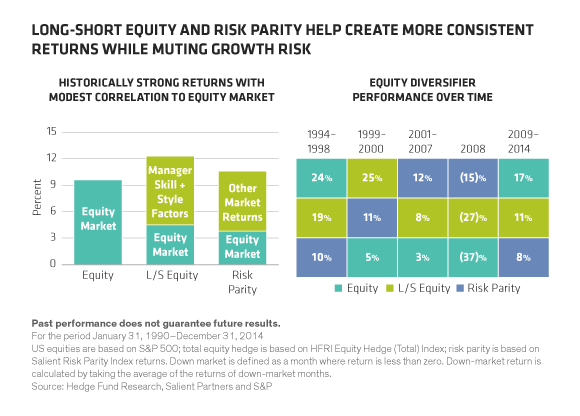Equities take a lead role in any target-date glide path because they’re the most reliable engine for investment growth. But even that engine could use some help in the future.
The failure to generate enough performance in the accumulation years has always shaped retirement investment decisions and will likely become an even bigger challenge in the next decade. A big reason for that is that quantitative easing by developed-market central banks has pushed down yields on both stocks and bonds toward historical lows.
All is not lost, however. We believe that combining equities with equity diversifiers can manage investment growth risks prudently without sacrificing returns. The role of equity diversifiers is to access other strategies that demonstrate strong growth potential but that have a more modest correlation to equity markets.
A number of good candidates exist to take diversification further than the traditional style (growth or value), geography and capitalization (small-, mid- and large-cap) categories. Two appealing diversifiers to long-only equities are long/short equity and risk-parity strategies. These three categories have had essentially comparable returns over the last 25-year period, but they’ve generated their returns from different sources, and they tend to grow at different paces and at different times in an economic cycle (Display).

Long/short equity generates more than half its returns from factors outside the benchmark movements of the equity market. What’s important in long/short equity strategies is manager skill (think “alpha diversification”). That means selecting securities, exposing the strategy to different factors that offer attractive returns within the market and tactically adjusting across factors to increase returns. Those factors could be value or growth styles, quality, profitability, or momentum strategies.
Risk-parity strategies generate diversification not by selecting individual securities but by diversifying across broad asset markets (think “beta diversification”). They don’t rely on equity market returns alone. They diversify their exposure across interest rates, commodities, credit and other asset classes. And they use some leverage to deliver a more consistent return pattern, structuring this part of the portfolio so that there’s an equal risk contribution from multiple asset classes.
There’s a clear benefit in using both long/short equity and risk-parity strategies in glide path design. That benefit typically surfaces during sharp market plunges, such as in 2008, but it’s even more worthwhile during lengthy periods of underperformance from equities. For example, in the 10-year period from 1999 through 2008, equities delivered an average annualized return of –1.4%, while long/short equity and risk parity actually delivered stable, more consistent return patterns of 6.9% and 9.0%, respectively.
The fundamental reason for diversification holds true here: no one asset class or strategy outperforms all the time. Those divergent returns for long/short equity and risk-parity strategies won’t happen over all periods. If we diversify away from equities when they’re the best-performing asset class, the other strategies will lag. That was the case during the bull market of the late 1990s—and that has also happened since the end of the recent financial crisis. But better diversification—in this case, incorporating equity diversifiers—helps create a more consistent level of growth over the long term. And we believe that adding equity diversifiers won’t sacrifice long-term portfolio growth; it will actually enhance it.
The views expressed herein do not constitute research, investment advice or trade recommendations and do not necessarily represent the views of all AB portfolio-management teams.
"Target date" in a fund's name refers to the approximate year when a plan participant expects to retire and begin withdrawing from his or her account. Target-date funds gradually adjust their asset allocation, lowering risk as a participant nears retirement. Investments in target-date funds are not guaranteed against loss of principal at any time, and account values can be more or less than the original amount invested—including at the time of the fund's target date. Also, investing in target-date funds does not guarantee sufficient income in retirement.